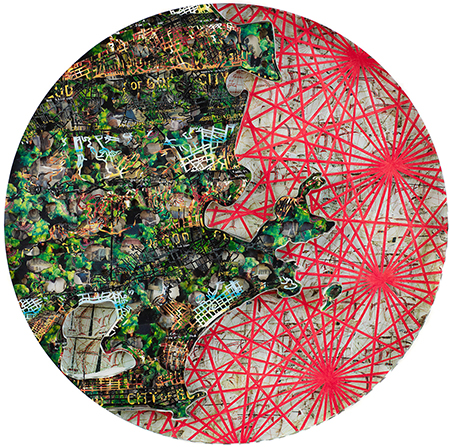
Continuing through June 2, 2018
With its gleaming gold leaf and trenchant subject matter, Matthew Picton’s “El Dorado” considers the millennia-old quest for the precious metal, enduringly apropos in an era when political campaigns commence in gold-plated hotel lobbies built by and for billionaires. Picton deftly tackles the ambiguities of human greed in a suite of his signature conceptual wall sculptures. Erudite in cultural history, he has long created thoroughly researched depictions of cities and river systems as they evolve over time. Slicing and dicing archival papers and boards with a surgeon’s precision, he painstakingly shapes them into stylized maps. Some incorporate a topographical element, with sinuous planes rising and falling from surfaces, held in place by pins. A striking example is “Histories of the Congo River #2,” a whopping 10-foot-diameter tondo composition installed directly on the gallery wall.
Other works are immaculately framed under glass, resplendent with metallics, hot pinks, and a garden of tropical greens. Cinematic imagery informs “Apocalypse Now,” which superimposes Francis Ford Coppola’s 1979 movie classic atop a portrayal of the lower Mekong Delta of Vietnam. “Venice #2” tips a hat to Frederico Fellini’s “Casanova” (1976). These filmic touches impart a lyricism and narrative that contrast effectively with the work’s fastidious formalism. In the mode of double-coding and commodity critique, Picton deploys the seductiveness of reflective surfaces and high-keyed chromaticism to illuminate the atrocities that imperialist powers continue to commit in their lust for all things lucrative and lustrous.
